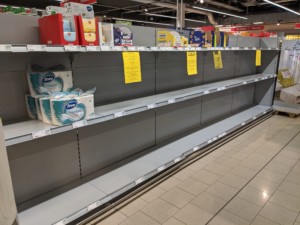 The next pillar in this series on Total Productive Maintenance (TPM) is planned maintenance. The idea is instead of fixing issues after the machine breaks, you do maintenance so it doesn’t break in the first place. Like autonomous maintenance, this is one of the pillars where TPM really shines and adds value to manufacturing. Let’s have a deeper look into planned maintenance.
The next pillar in this series on Total Productive Maintenance (TPM) is planned maintenance. The idea is instead of fixing issues after the machine breaks, you do maintenance so it doesn’t break in the first place. Like autonomous maintenance, this is one of the pillars where TPM really shines and adds value to manufacturing. Let’s have a deeper look into planned maintenance.
The Pillars of TPM – Autonomous Maintenance
 This small series on Total Productive Maintenance (TPM) looks at the pillars of the TPM framework. This particular post focuses on the topic of autonomous maintenance, which I think is a valid and useful pillar of TPM. It is one of the pillars of the framework where TPM really shines and adds a lot of value to industry. Sometimes it is even listed as the first pillar to underline its importance for maintenance. The ideas of autonomous maintenance can be applied in almost any shop floor, improving the overall system performance and reducing the cost.
This small series on Total Productive Maintenance (TPM) looks at the pillars of the TPM framework. This particular post focuses on the topic of autonomous maintenance, which I think is a valid and useful pillar of TPM. It is one of the pillars of the framework where TPM really shines and adds a lot of value to industry. Sometimes it is even listed as the first pillar to underline its importance for maintenance. The ideas of autonomous maintenance can be applied in almost any shop floor, improving the overall system performance and reducing the cost.
The Pillars of TPM – Focused Improvement
 In this and subsequent posts I will have a deeper look at the different pillars of Total Productive Maintenance (TPM). This first post looks at the pillar of focused improvement, which is practically identical with continuous improvement. However, it can be argued if this should be its own pillar or if it should be part of the foundation of a house. I will tell you which parts I like and which ones I don’t, based on my knowledge in lean. Hopefully this helps you to figure out which parts to use, which ones to not use, and which ones to modify to fit your shop floor. But feel free to disagree. I am looking forward to your comments, as I will surely learn something form them. Anyway, let’s have a look at this pillar through my “lean glasses.”
In this and subsequent posts I will have a deeper look at the different pillars of Total Productive Maintenance (TPM). This first post looks at the pillar of focused improvement, which is practically identical with continuous improvement. However, it can be argued if this should be its own pillar or if it should be part of the foundation of a house. I will tell you which parts I like and which ones I don’t, based on my knowledge in lean. Hopefully this helps you to figure out which parts to use, which ones to not use, and which ones to modify to fit your shop floor. But feel free to disagree. I am looking forward to your comments, as I will surely learn something form them. Anyway, let’s have a look at this pillar through my “lean glasses.”
An Overview of the Eight Pillars of Total Productive Maintenance
 Total Productive Maintenance (TPM) is the best known framework for organizing maintenance. In this post I would like to dig deeper into its ideas and how it works. The principles of TPM are often arranged as “eight pillars,” although there are different views of what these eight pillars are. Let me give you an overview of these. In this post I will also look at the general problem of maintenance. In subsequent posts I will be going deeper into the individual pillars.
Total Productive Maintenance (TPM) is the best known framework for organizing maintenance. In this post I would like to dig deeper into its ideas and how it works. The principles of TPM are often arranged as “eight pillars,” although there are different views of what these eight pillars are. Let me give you an overview of these. In this post I will also look at the general problem of maintenance. In subsequent posts I will be going deeper into the individual pillars.
I will try to not only give a brief explanation how all the pillars work, but also give my opinion on which pillars I find useful and which one I don’t. There are some excellent elements in this framework that everybody should use on the shop floor, but there are also additional pillars that to me serve little purpose. In any case, I look forward to hearing your opinion in the comments.
What Are the Goals of Maintenance?
 In my last post I looked at the history of maintenance. This post goes into more detail on the reasons why you should do maintenance. There are many more than merely to improve uptime. Let’s have a look at the different goals of maintenance. For illustration I will use the example of a car, since you are probably at least somewhat familiar with the maintenance of your car.
In my last post I looked at the history of maintenance. This post goes into more detail on the reasons why you should do maintenance. There are many more than merely to improve uptime. Let’s have a look at the different goals of maintenance. For illustration I will use the example of a car, since you are probably at least somewhat familiar with the maintenance of your car.
A Brief History of Maintenance
 At the suggestion of multiple readers, I would like to take a deeper look into maintenance, especially total productive maintenance (TPM). Maintaining your machines and tools is important for your business. In many places, maintenance seems to be more reactive: if it breaks, fix it. Often, a better approach would be proactive maintenance: maintain it so it doesn’t break in the first place. In this first post in this series of articles on maintenance, I would like to look a bit into the history of maintenance. Subsequent posts will look deeper into why we need to maintain our stuff and how to do it. The overarching theme is guided by total productive maintenance, but I won’t hesitate to give my critical opinion where necessary.
At the suggestion of multiple readers, I would like to take a deeper look into maintenance, especially total productive maintenance (TPM). Maintaining your machines and tools is important for your business. In many places, maintenance seems to be more reactive: if it breaks, fix it. Often, a better approach would be proactive maintenance: maintain it so it doesn’t break in the first place. In this first post in this series of articles on maintenance, I would like to look a bit into the history of maintenance. Subsequent posts will look deeper into why we need to maintain our stuff and how to do it. The overarching theme is guided by total productive maintenance, but I won’t hesitate to give my critical opinion where necessary.
What Is a Good Minimum for the Supermarket?

A minimum level in a supermarket gives you a warning that a stock out is imminent. Hopefully it also gives you enough time to prevent such a stock out, even though this may result in firefighting. In my last post I talked on how to use a minimum level. This post will look at how to determine a good minimum level.
How to Use a Minimum in a Supermarket

The kanban formula (or estimation) helps you determine the number of kanban. All of these should fit in the supermarket, hence the maximum in the supermarket represents all kanban. Many supermarkets also have a minimum inventory level. Unfortunately, there is little information on how to set the minimum. Time to take a deeper look on how to set and use the minimum level in the supermarket. In this first post I will look at how to use a minimum level in a supermarket. The next post will look at how to determine a good minimum level.
